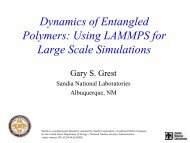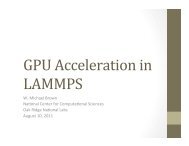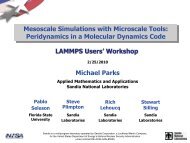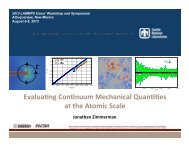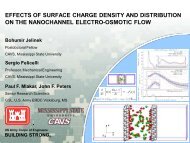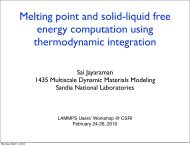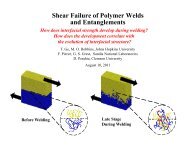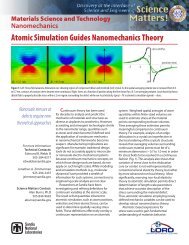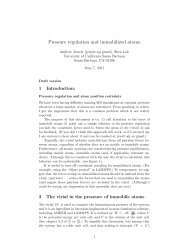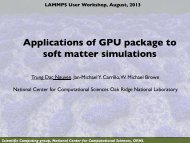Molecular Dynamics Simulation of Strontium Titanate - Lammps
Molecular Dynamics Simulation of Strontium Titanate - Lammps
Molecular Dynamics Simulation of Strontium Titanate - Lammps
You also want an ePaper? Increase the reach of your titles
YUMPU automatically turns print PDFs into web optimized ePapers that Google loves.
CHIN. PHYS. LETT. Vol. 27, No. 2 (2010) 026501<br />
al. [20] C P is 90.08 Jmol −1 K −1 at 400 K, and it increases<br />
to 138.66 Jmol −1 K −1 at 1800 K, this agrees with the<br />
data in the literature, which indicates that the potential<br />
function used in the present study describes well<br />
the change in the internal energy <strong>of</strong> SrTiO 3 with temperature.<br />
Heat capacity (JSmol -1 SK -1 )<br />
140<br />
130<br />
120<br />
110<br />
100<br />
90<br />
Our result<br />
de Ligny . 1996<br />
Coughlin . 1953 ( )<br />
0 400 800 1200 1600 2000<br />
Temperature (K)<br />
Fig. 4. Temperature dependence <strong>of</strong> the heat capacity at<br />
constant pressure for SrTiO 3 , together with de Ligny et<br />
al. [19] and Coughlin et al. [20]<br />
Thermal coductivity<br />
lat (Wm -1 K -1 )<br />
10<br />
8<br />
6<br />
4<br />
Our result<br />
Muta . 2005<br />
Ito . hot-press at 1473 K<br />
Ito . hot-press at 1673 K<br />
400 600 800 1000<br />
Temperature (K)<br />
Fig. 5. Temperature dependence <strong>of</strong> lattice contributions<br />
to the thermal conductivity for SrTiO 3 , together with<br />
Muta et al. [11] and Ito et al. [21]<br />
Figure 5 shows the temperature dependence <strong>of</strong> κ lat<br />
<strong>of</strong> SrTiO 3 , together with Muta et al. [11] and Ito et<br />
al. [21] Here the κ lat value is 12.64 Wm −1 K −1 at 300 K,<br />
and it decreases to 2.25 Wm −1 K −1 at 1100 K, it almost<br />
agrees with the data <strong>of</strong> Muta et al. [11] in the<br />
temperature range from 300 to 800 K. It indicates that<br />
our model can describe the thermal conductivity <strong>of</strong><br />
SrTiO 3 . Of course, the total thermal conductivity<br />
κ total is evaluated from the relationship:<br />
κ total = κ lat + κ el + κ other , (9)<br />
where κ el is the electrical contribution to the thermal<br />
conductivity, and κ other is the other contribution to<br />
the thermal conductivity. The evaluated results <strong>of</strong> the<br />
molecular dynamics simulation represent κ lat only.<br />
In summary, the molecular dynamics method has<br />
been used in simulation <strong>of</strong> the thermophysical properties<br />
<strong>of</strong> SrTiO 3 .We obtain the results that the lattice<br />
parameter, linear thermal expansion coefficient, and<br />
heat capacity increase with increasing temperature,<br />
and the decreases <strong>of</strong> lattice contributions on the thermal<br />
conductivity with increasing temperature agree<br />
with data in the literature. It shows that the molecular<br />
dynamics simulation is very useful for evaluating<br />
the thermophysical properties <strong>of</strong> thermoelectric materials<br />
such as SrTiO 3 . Supported by the Commission<br />
on Higher Education, CHE-RES-PD project, Ministry<br />
<strong>of</strong> Education, Thailand.<br />
References<br />
[1] Iwahara H, Esaka T, Uchida H, Macula N 1981 Solid State<br />
Ionics 3/4 359<br />
[2] Iwahara H, yajima T, Hibino T, Ushida H 1993<br />
J. Electrochem. Soc. 140 1687<br />
[3] Kurita N, Fukatsu N, Ohashi T 1994 J. Spn. Inst. Metals 58<br />
782<br />
[4] Yajima T, Koide K, Takai H, Fukatsu N, Iwahara H 1995<br />
Solid State Ionics 79 333<br />
[5] Gerblinger J, Meixner H 1991 Sensors Actuators 4 99<br />
[6] Fujimoto M, Kingery W D 1985 J. Am. Ceram. Soc. 68 169<br />
[7] Yamaoka N, Masuyama M, Fukui M 1983<br />
Am. Ceram. Soc. Bull. 62 698<br />
[8] Kawai M, Watanabe S, Hanada T 1991 J. Crystal Growth.<br />
112 745<br />
[9] Mavroides J G, kafalas J A, Kolesar D F 1976<br />
Appl. Phys. Lett. 28 241<br />
[10] Henrich V E 1985 Rep. Prog. Phys. 48 1481<br />
[11] Muta H, Kurosaki K and Yamanaka S 2005 J. Alloy Compd.<br />
392 306<br />
[12] Matsushita E and Tanase A 1997 Solid State Ionics 97 45<br />
[13] Sata N, Hiramoto K and Ishigame M 1996 Phys. Rev. B 54<br />
15795<br />
[14] Yukawa H, Nakatsuka K and Morinaga M 1999 Solid State<br />
Ionics 116 89<br />
[15] Seetawan T, Khuangthip T, Amornkitbamrung V, Kurosaki<br />
K, Adachi J., Katayama M, Charoenphakdee A and Yamanaka<br />
S 2008 Master. Rec. Soc. Symp. Proc. (USA: Materials<br />
Research Society) vol 1043 p 1043-T09-09<br />
[16] Seetawan T, Vora-ud A and Amornkitbamrung V 2008<br />
Siam Physics Congress (Khao Yai, Nakhon Ratchasima,<br />
Thailand 20–22 March 2008) A-9<br />
[17] Zwanzig R 1965 Ann. Rev. Phys. Chem. 16 67<br />
[18] Zhang Q Y, Jiang S W and Li Y R 2006<br />
J. Comput. Aid. Mol. Des. 13 213<br />
[19] de Ligny D and Richet P 1996 Phys. Rev. B 53 3013<br />
[20] Coughlin J P and Orr R L 1953 J. Am. Chem. Soc. 75 530<br />
[21] Ito M and Matsuda T 2009 J. Alloy Compd. 477 473<br />
026501-3



